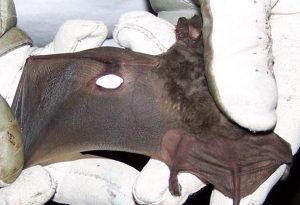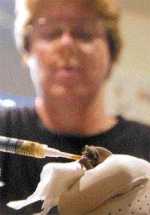
NorCalBats is dedicated to the rescue, rehabilitation and release of bats throughout Northern California. Our trained volunteers care for injured and orphaned bats throughout the Sacramento Valley and surrounding foothills.
What To Do If You Find a Bat
NEVER HANDLE WILD ANIMALS, INCLUDING BATS, WITH YOUR ![]()
If you find a bat that does not appear to be sick or injured, the best advice is usually to leave the bat alone, at least until you can determine if it is having difficulties.
If the bat is flying inside the home, open the doors or windows. Turn inside lights out and turn on outside lights. The bat will follow the bugs which are attracted to the light.
See What To Do If You’ve Found A Bat for suggestions on how to deal with a bat that doesn’t need to be rescued. Remember, never touch a bat bare-handed!
A bat is a wild animal. When it is picked up it will bite. Bats are small, so when they are on the ground, people tend to approach them. When they are sick or injured a bat often lies quietly and looks calm until they are touched, then they will try to protect themselves. Humans should never touch a bat without protecting themselves. Most people wouldn’t pick up an injured or sick raccoon or feral cat without protecting ourselves, but somehow people don’t stop and think about the dangers of being bitten by a bat. If the bat is touched with bare hands, the bat must be tested for rabies; this means the bat will need to be killed. If the bat escapes, the person should contact their health provider to evaluate the need for rabies vaccination. Many animals do not show symptoms of rabies until the disease has progressed. Signs and symptoms vary between species. Generally bats do not become ferocious when they display signs of rabies. They don’t foam at the mouth, or have other symptoms for which we are more familiar. Just because a bat is not acting vicious doesn’t mean it’s not sick. For more information see the CDC website.
If The Bat is Sick or Injured
If you are sure that the bat is sick or injured, contact your local wildlife rehabilitation facility. Again, never handle the bat with your bare hands, for the safety of both you and the bat!
- Sacramento valley and nearby foothills: Contact NorCal Bats at 530-902-1918, and we will try to arrange a pickup. We are volunteers, sometimes there are limits to what we can do.
- Other areas in California: Check the California Department of Fish & Wildlife website that lists Wildlife Rehabilitation Facilities by county.
- Outside of California: Use the Bat World Local Rescue website and search by city or zip code.
If You Are Sure No Bare Skin Contact Has Occurred
- Wait until the bat is motionless. Move slowly and calmly.
- Cover the bat with a box or container.
- If the bat must be moved, wear heavy gloves for your safety and the safety of the bat. Use a small box or coffee can and a piece of cardboard to scoop the bat into a box or other small container.
- Place a cloth such as t-shirt material (nothing with loops that can catch the bat’s toes) in the box to give it a place to cling and hide. Water can be offered by placing it in a very shallow container (like a baby food jar lid).
- Make sure the box with the bat is safe from predators, pets and children; in a calm quiet place, out of the direct sun.
- Call your local wildlife rehabilitation facility, such as NorCal Bats at 530-902-1918. Don’t send an e-mail.
- Do not attempt to rehabilitate the bat on your own or try to keep it as a pet. Bats have very specific dietary and environmental requirements. A trained rehabilitator will be familiar with the needs of the various bat species. Also, it is not legal to keep any wildlife as a pet.
NORCAL BATS EMERGENCY CONTACT NUMBER: 530-902-1918
Here’s a video that will show you a simple method of containing a bat until you get in touch with a wildlife rescue group:
How We Rescue Bats
 We receive calls from homeowners, veterinary offices, businesses and other wildlife rehabilitation groups. A volunteer retrieves the bat and the animal is evaluated.
We receive calls from homeowners, veterinary offices, businesses and other wildlife rehabilitation groups. A volunteer retrieves the bat and the animal is evaluated.
Orphaned bats are fed special formula and cared for around the clock until the bat is old enough to fly. It learns to eat insects then joins others in a flight cage to build up its strength. Once ready, it rejoins a wild colony.
Adults may need medication, repair to a broken bone, hydration or other types of care. We work closely with a veterinarian to provide proper treatment. The bat is taught to eat mealworms and given a chance to heal and recuperate. Once it is restored to a condition of good health, it is released to the wild.
If an animal can not be released due to complications that would prevent its success in the wild, it is evaluated for suitability in our education program.
NORCAL BATS EMERGENCY CONTACT NUMBER: 530-902-1918
Help Bat Research by Reporting Bat Observations
Little is known about bat roosting locations in the State of California. With the help of the public, the California Department of Fish and Wildlife (CDFW) is working to increase our knowledge about bats. You can help by reporting bat roosting locations, as well as reporting observations of sick or dead bats.
This is particularly important in the study of White Nose Syndrome, a debilitating disease of bats (which doesn’t affect humans) that has decimated some bat colonies in the eastern USA. The DNA of the fungus that causes this disease has been discovered in California, and the CDFW wants to gather information about locations where bat colonies can be found, as well as reports of sick/dead bats.
- Use the Report a Bat Colony website to inform CDFW about bat colonies you observe in your area.
- Use the Report a Sick or Dead Bat website to inform CDFW about sick or dead bats you may come across.
- You can also read about White Nose Syndrome.
